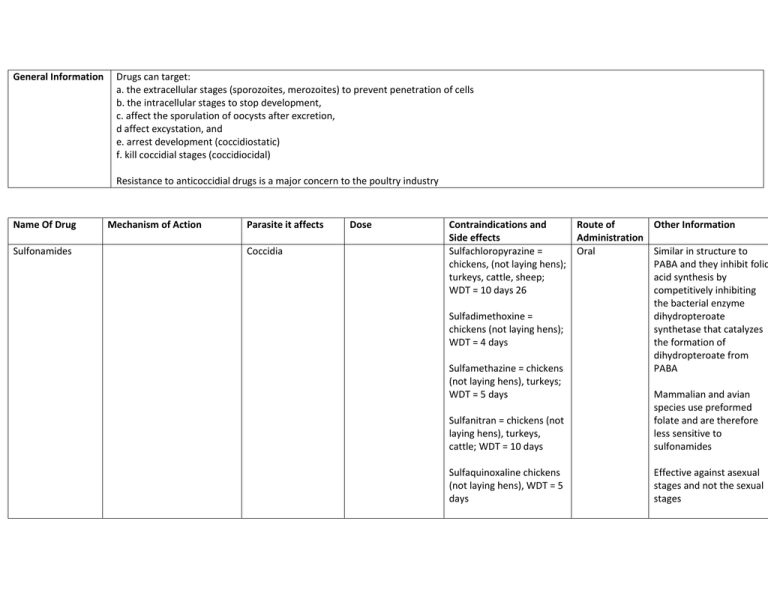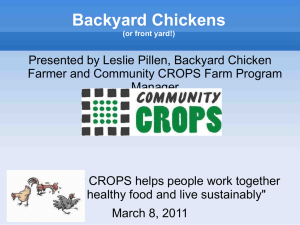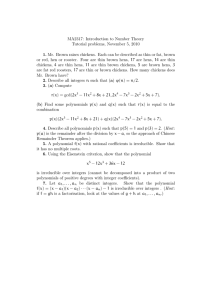General Information b. the intracellular stages to stop development,
advertisement

General Information Drugs can target: a. the extracellular stages (sporozoites, merozoites) to prevent penetration of cells b. the intracellular stages to stop development, c. affect the sporulation of oocysts after excretion, d affect excystation, and e. arrest development (coccidiostatic) f. kill coccidial stages (coccidiocidal) Resistance to anticoccidial drugs is a major concern to the poultry industry Name Of Drug Sulfonamides Mechanism of Action Parasite it affects Coccidia Dose Contraindications and Side effects Sulfachloropyrazine = chickens, (not laying hens); turkeys, cattle, sheep; WDT = 10 days 26 Sulfadimethoxine = chickens (not laying hens); WDT = 4 days Sulfamethazine = chickens (not laying hens), turkeys; WDT = 5 days Route of Other Information Administration Oral Similar in structure to PABA and they inhibit folic acid synthesis by competitively inhibiting the bacterial enzyme dihydropteroate synthetase that catalyzes the formation of dihydropteroate from PABA Sulfanitran = chickens (not laying hens), turkeys, cattle; WDT = 10 days Mammalian and avian species use preformed folate and are therefore less sensitive to sulfonamides Sulfaquinoxaline chickens (not laying hens), WDT = 5 days Effective against asexual stages and not the sexual stages Do not impair immunity development Hydroxyquinolones Coccidiostatic and Naphthoquinoones Decoquinate May block DNA synthesis by inhibiting DNA gyrase The quinolone anticoccidials (e.g., Parvaquone) are thought to inhibit transfer of electrons from ubiquinone to cytochrome c during electron transport in the parasites' mitochondria Amprolium Appears to competitively inhibit active transport of thiamine in isolated second generation schizonts of E. tenella Prevent merozoite production and also affect sexual stages and the sporulating oocyst Coccidia Coccidia in calves, beef and nonlactating cattle, sheep, goats and poultry Dogs: Prophylaxis: 50 mg/kg PO once daily Cattle: Using the 6% premix: 0.5 mg/kg per day in feed for at least 28 days Goats: 0.5 mg/kg per day in feed during periods of exposure Coccidia in layers Dogs: 100 - 200 mg/kg PO in food or water for 710 days. Cattle: Treatment: 10 mg/kg PO for 5 days; 5 mg/kg for 21 days for prophylaxis Swine: Treatment: 25 - 65 mg/kg PO once or twice daily for 3-4 days. Sheep and Goats: Lambs: 55 mg/kg daily PO for 19 days. Birds: Decoquinate is not effective for treating clinical coccidiosis and has no efficacy against adult coccidia. Decoquinate is not approved for use in animals producing milk for food or in laying chickens. Oral Overdose can result in thiamine deficiency Oral Not recommended to be used for over 12 days in puppies Poorly absorbed from the GIT and rapidly cleared Decoquinate is reportedly incompatible with strong bases or oxidizing material. Follow label storage directions; store in a cool, dry place. Structurally similar to thiamine, except that it lacks the Hydroxyethyl function of thiamine which prevents phosphorylation to a pyrophosphate analog. It is the only anticoccidial approved for layers -For coccidiosis in pet birds: 2 ml (using the 9.6% solution)/gallon of water for 5 days or longer. Cages should be steam cleaned to prevent reinfection. Supplement diet with B vitamins. Roxarsome Polyether Ionophores (monovalent, monovalent glycoside, divalent, divalent glycoside, divalent pyrole ethers) Monensin (Coban®, Rumensin®) Arsenical drug is used primarily for its growthpromoting benefits, and is often used in combination with other drugs to enhance anticoccidial activity Different Ionophores have different affinities for different cations Form lipophilic complexes with alkali metal cations and to transport these complexes across biological membranes. The result is an increase influx of intracellular Na+ levels that exceeds the capacities of the 28 Na+/K+ pump to remove excess Na+. To maintain electro neutrality within the sporozoite, there is an increase in Cl- levels which then draws water into the cell and results in cellular swelling. Cattle, goats, and chickens coccidia It should not be given to mature turkeys and guinea fowl. Chickens exposed to Ponazuril Sarcocystis neurona (Equine protozoal myeloencephalitis (EPM)) Antiprotozoal Oral Paste is supplied in ready-to-use syringes containing 127 grams of paste to be used at a dose of 5 mg/kg (2.27 mg/lb) body weight once daily for a period of 28 days Concentration of Ponazuril necessary to kill Sarcocystis neurona in vitro was 0.1 to 1.0 μg/mL. feed containing monensin + tiamulin can interfere with monensin metabolism and cause weight suppression. The WDT can be 0 or 5 days depending on the other active ingredients in the formulation The safety of this drug in pregnant or lactating mares has not been evaluated. This drug should not be used in horses intended for food Oral Paste

